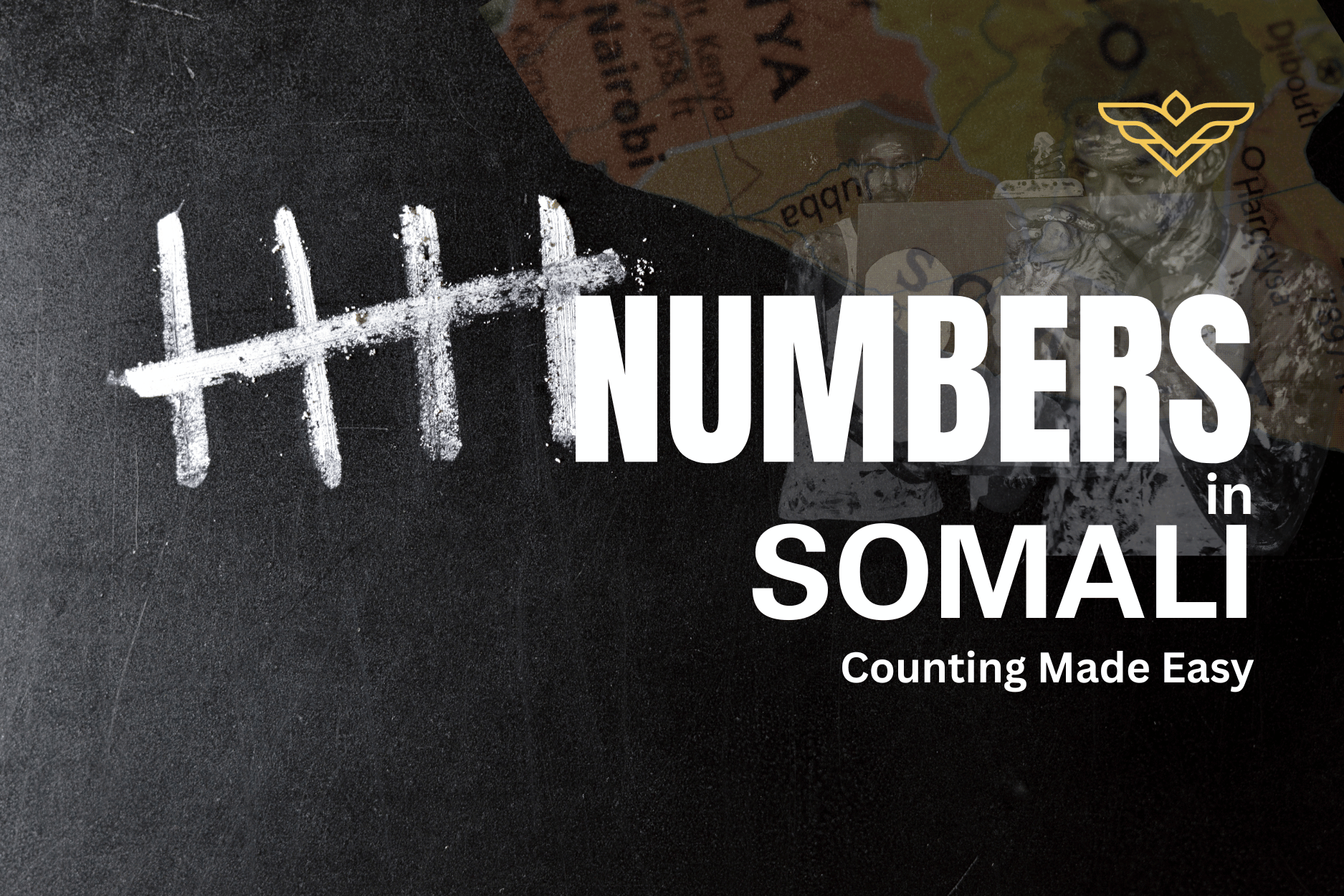Numbers in Somali: Counting Made Easy
By: Chimdindu Ken-Anaukwu
Why Numbers Matter in Somali
Numbers are the bones of language; they hold everything together. Whether you’re haggling in a Somali market, scheduling a boda ride, or buying tea for your friends, you’ll need them.
In Somali, numbers are logical, musical, and sometimes mischievous. Once you learn the rhythm, you’ll start hearing them everywhere, from the mosque to the market, from phone numbers to the number of sugar spoons in your shaah (spoiler: it’s always too many).
Counting 1–10 (The Foundation)
Let’s start simple. These are your building blocks:
| Number | Somali | Pronunciation (roughly) |
|---|---|---|
| 1 | Kow | ko |
| 2 | Laba | la-bah |
| 3 | Saddex | sa-dekh |
| 4 | Afar | ah-far |
| 5 | Shan | shan |
| 6 | Lix | likh |
| 7 | Toddoba | to-do-bah |
| 8 | Sideed | si-dayd |
| 9 | Sagaal | sa-gal |
| 10 | Toban | to-ban |
From 11 to 100: How to Build Bigger Numbers
After ten, the pattern is beautifully logical.
You take toban (10) and add the next number.
11 → Kow iyo toban (1 and 10)
12 → Laba iyo toban
13 → Saddex iyo toban
…and so on!
Tens are just as smooth:
| Number | Somali |
|---|---|
| 20 | Labaatan |
| 30 | Soddan |
| 40 | Afartan |
| 50 | Konton |
| 60 | Lixdan |
| 70 | Toddobaatan |
| 80 | Sideetan |
| 90 | Sagaashan |
| 100 | Boqol |
Once you hit 100, you can add from there:
Boqol iyo kow → 101
Boqol iyo toban → 110
Laba boqol → 200
See? Easy. Somali math is just poetry in disguise.
Counting Things: Nouns and Numbers in Somali
Here’s where things get a bit spicy.
Somali numbers agree with the noun they describe. That means the gender (masculine or feminine) of the noun affects the word for one and two.
Example:
Hal nin → one man
Hal gabar → one girl
Laba nin → two men
Labo gabar → two girls
From three upward, the gender distinction usually disappears.
So:
Saddex buug → three books
Afar daaqado → four windows
Ordinal Numbers (First, Second, Third...)
When you want to describe order, like “first day” or “third child”, Somali has you covered.
| English | Somali |
|---|---|
| First | Kowaad |
| Second | Labaad |
| Third | Saddexaad |
| Fourth | Afraad |
| Fifth | Shanaad |
Example:
Maalinta kowaad → the first day
Gabadha labaad → the second girl
Simple structure, elegant sound.
Everyday Situations Where You’ll Need Somali Numbers
At the Market:
“Lix kilo oo bariis ah.” → Six kilos of rice.
(Pro tip: say it confidently — the price might drop miraculously.)At Home:
“Sagaal qof ayaa imanaya.” → Nine people are coming.
(Also, prepare extra sambuus. Nine might actually mean fourteen.)On the Phone:
“Nambarka waa toddoba, lix, laba, afar...”
Somali speakers tend to say numbers clearly — like poetry on the line.During Ramadan or Festivals:
Counting days, gifts, or how many times your cousin’s plate “accidentally” refills itself.
Common Mistakes (And Funny Mix-ups)
❌ Mixing “iyo” (and) placement
✅ Say kow iyo toban (1 and 10), not toban iyo kow.
❌ Forgetting gender in 1 & 2
✅ Hal gabar, not kaw gabar.
❌ Confusing “toban” and “soddan”
✅ One’s ten, the other’s thirty. But don’t worry — even locals mumble them fast sometimes!
FAQ: Counting in Somali
Q1: Are Somali numbers used in all regions?
Yes — though some dialects have small pronunciation shifts.
Q2: Do Somalis use Arabic numerals (1, 2, 3...)?
Absolutely. Somali numbers are used in speech, while Arabic numerals appear in writing and math.
Q3: How do I say 1000?
Kun. So, kun iyo toban = 1010.
Q4: Are there plural rules after numbers?
Yes. After numbers, Somali nouns usually appear in singular form — even if you’re talking about many items.
Q5: What’s the fastest way to learn numbers?
Count everything around you out loud, from spoons to buses to TikTok followers. Daily repetition works magic.
Final Thoughts
Somali numbers aren’t just digits, they’re alive with culture and pattern. Each word carries rhythm, logic, and a musical pulse that makes counting feel right.
So the next time you buy bananas or camels (hey, you never know), flex your Somali numbers proudly.
And if you forget mid-count?
Smile, start again. Somalis love enthusiasm more than perfection.
